The founder of Kyokushin karate, Sosai 総裁 (President) Masutatsu Oyama (大山 倍達 Ōyama Masutatsu) was born as Choi Yeong-eui (Hangul: 최영의 Hanja: 崔永宜) on 27th July 1923 during the Japanese occupation, and subsequent annexation of Korea. Born in the village of Gimje (in Jeollabuk-do), not far from Gunsan in Southern Korea, his parents were Yangban (nobility) in the region. Mas Oyama was the youngest brother in a large family. His father and three older brothers were very large men – all strong and talented athletes. A Zainichi Korean, Mas Oyama – the name he is commonly known by – spent most of his life living in Japan and acquired Japanese citizenship in 1964.
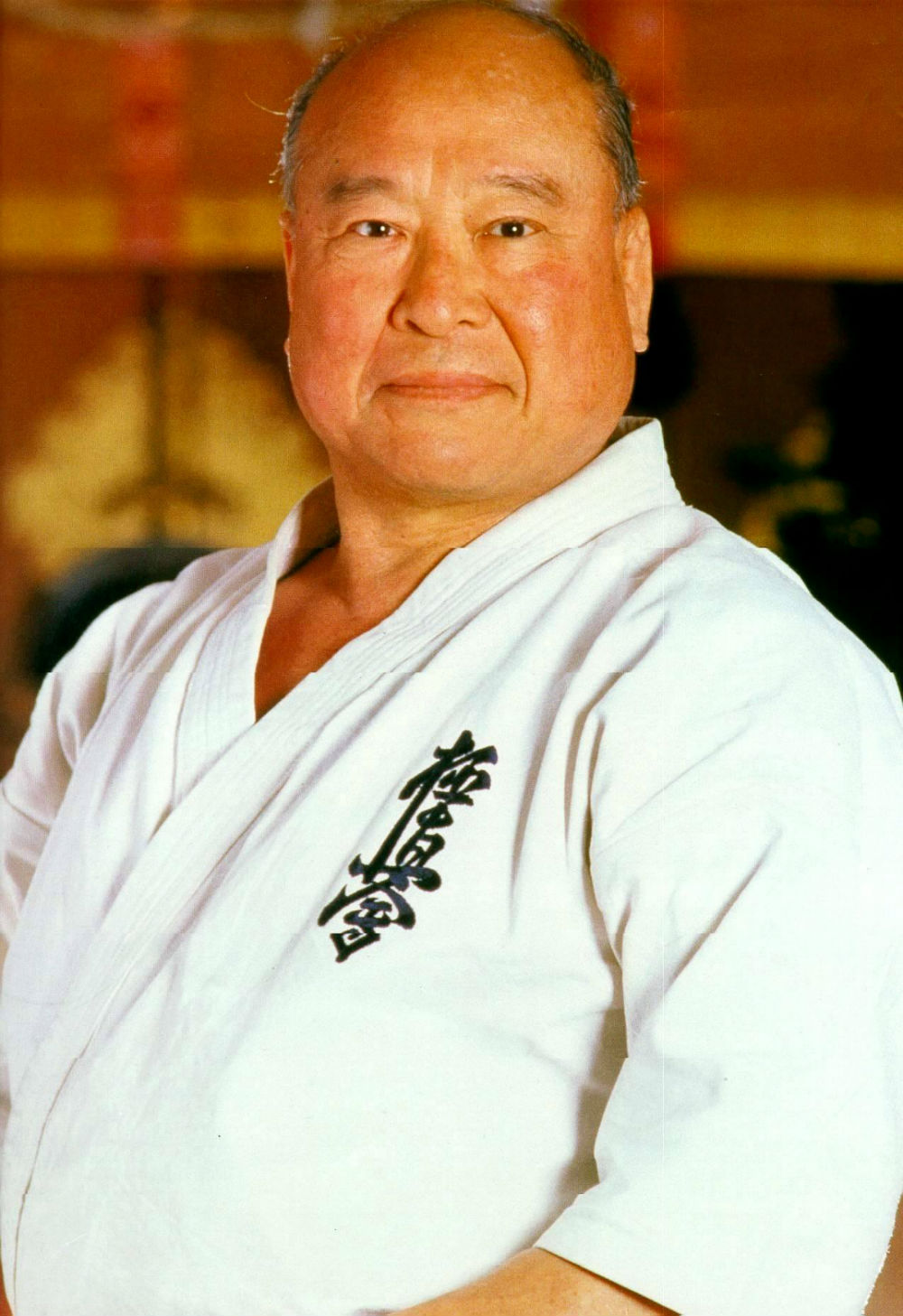
At a relatively young age he was sent to Manchuria, in Southern China, to live on his sister’s farm. It was there that at the age of nine, he began his lifelong journey along the Martial Way when he began studying the southern Chinese form of kempo know as “Eighteen Hands” from a Mr. Yi who was at the time working on the farm. Yi (Lee?) gave the young Oyama a seed which he was to plant; when it sprouted, he was to jump over it one hundred times every day. As the seed grew and became a plant, Oyama later said, “I was able to jump between walls back and forth easily.” When Mas Oyama returned to Korea at the age of 12, he continued his training in Korean kempo. After four years of hard work and training Oyama was already known as Gaki Taisho, or “little protector of the weak”. Even at this age, he challenged the boys at 2 and 3 years older than himself, when they dare to bully his friends.
In March 1938, at the age of 15, Oyama left for Japan following his brother who enrolled in the Yamanashi Aviation School Imperial Japanese Army aviation school. He was inspired to go to Japan by General Kanji Ishihara who was against the invasion of Asian neighbors (as a consequence, he was ostracized by higher ranks of the Japanese Army), to carve out his future in the heart of the Empire of Japan. Survival on his own at that age proved to be more difficult than he thought, especially as a Korean in Japan, and the aviator training fell by the wayside.
He did however continue his martial arts training by participating in judo and boxing.

When Mas Oyama became acquainted with Gichin Funakoshi , who had brought karate from Okinawa to Japan and developed what is now known as Shotokan Karate, he was very much impressed. Wanting the best in instruction, he contacted the Shotokan (Karate school) operated by Gigō Funakoshi, the second son of karate master Gichin Funakoshi. Mas Oyama practised intensively for a long time in the dojo of Funakoshi sensei at Takushoku University and progressed so rapidly that by the age of 17, he was a Nidan 二段 (2nd Dan), and by the age of 20, he was a Yondan 四段 (4th Dan) in Shotokan 松濤館流.
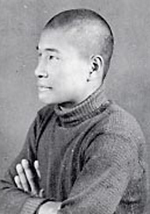
At this point he also took a serious interest in judo 柔道, and his progress there was no less amazing. By the time he had quit training in Judo, less than four years after he had started, he had achieved the rank of Yondan in Kosen Judo.
The defeat of Japan and the subsequent indignity of Occupation almost proved to be too much for Mas Oyama, who nearly despaired. In 1945 after the war ended Oyama left the Aviation school. He began “Eiwa Karate Reseach Center” in Suginami ward but closed quickly because “I soon realized that I was an unwanted Korean. Nobody would rent me a room.” He finally found a place to live at a corner of Tokyo.
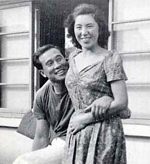
This is where he met his future wife whose mother ran a dormitory for university students. In 1946, Oyama enrolled in the Department of Physical Education at Waseda University.
Korea had been officially annexed by Japan since 1910. During World War II (1939–1945) there was much unrest throughout Korea. As South Korea began to fight against North Korea over political ideology, Oyama became increasingly distressed. He recounts, “though I was born and bred in Korea, I had unconsciously made myself liberal; I felt repulsion against the strong feudal system of my fatherland, and that was one of the reasons which made me run away from home to Japan.” He joined a Korean political organization in Japan to strive for the unification of Korea, but soon was being targeted and harassed by the Japanese police.
Around the time he also went around Tokyo getting in fights with the US Military Police. He later reminisced those times in a television interview, “Itsumitemo Haran Banjyo” (Nihon Television), “I lost many friends during the war- the very morning of their departure as Kamikaze pilots, we had breakfast together and in the evening their seats were empty. After the war ended, I was angry- so I fought as many US Military as I can, until my portrait was all over the police station.”
Fortunately, after the end of World War II, Mas Oyama met Mr. So Neichu (another Korean – from Oyama’s own province – living in Japan).
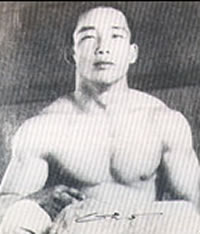
Master So was one of the highest authorities in Japan of Goju Ryu 剛柔流, an Okinawan karate style, and was a senior student of the system’s founder, Chojun Miyagi. He was renowned for the power of his body as well as his spiritual insight, and as Mas Oyama started training under him, it was Master So who encouraged him to dedicate his life to Budo 武道, the Martial Way. It was he too who suggested that Mas Oyama retreat from civilization for three years to train his mind and body without the distractions of the outside world.
Around this time, Mas Oyama also met Eiji Yoshikawa, the author of the novel Musashi 武蔵, which was based on the life and exploits of Miyamoto Musashi, Japan’s most famous Samurai warrior. Both the novel and the author helped to teach him the meaning of Bushido 武士道, the Way of the Warrior.
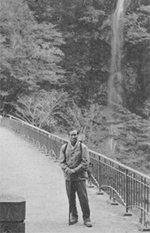
That same year, Mas Oyama went to Mt. Minobu in Chiba Prefecture, where Musashi had developed his Nito-Ryu style of sword fighting. Mas Oyama thought that this would be an appropriate place to begin the rigorous training he had planned for himself. Accompanied by Yashiro, one of his pupils, and taking with him only what he really needed (a katana (traditional Japanese sword) , Yari (spear), dishes, as well as some books, among which was a copy of Yoshikawa’s book), he went into the wilderness there to train, with a friend bringing food supplies to them once a month.
After six months however, overcome by loneliness, Yashiro left the mountain, leaving Mas Oyama completely alone to continue his training. It became even harder for Oyama, who with only monthly visits from a friend in the town of Tateyama in Chiba Prefecture, wanted more than ever to return to civilisation. So Neichu wrote to him that he should shave off an eyebrow in order to get rid of the urge. Surely he wouldn’t want anyone to see him that way! This and other more moving words convinced Oyama to continue, and he resolved to become the most powerful karate-ka in Japan. After fourteen months of training in the wilderness, his friend informed Mas Oyama that he could no longer provide the monthly supplies of food, and Mas Oyama had to return to civilization.
A few months later, in 1947, Mas Oyama won the karate section of the first Japanese National Martial Arts Championships after World War II. However, still feeling empty for not having completed the three years of solitude (yamagomori), he decided to dedicate his life completely to karate.

Once again Mas Oyama left civilization for the wilderness, this time going to Mt. Kiyozumi, also in Chiba Prefecture, which he chose for its spiritually uplifting environment. Here, in 1253, the monk Nichiren declared heaven and earth on the birth of a new sect – Hokke-shu, which in our time is the most numerous sect of Buddhists in Japan.
This time his training was fanatical — 12 hours a day, every day, with no rest days, standing under cold buffeting waterfalls, breaking river stones with his hands, using trees as makiwara 巻藁 (striking boards), jumping over rapidly growing flax plants hundreds of times each day. Each day also included a period of study of the ancients classics on the martial arts, Zen, and philosophy. After eighteen months of rigorous training, Mas Oyama returned to civilization fully confident in himself and able to take control of his life. Never again would he be so heavily influenced by his society around him. (Though it is probably safe to say that his circumstances were also probably never again as traumatic!)
In the 1950s, Sosai (Founder) began testing and demonstrating his power and skill by fighting bulls. The first “fight” took place in Tateyama, and in all, he fought 52 bulls, three of which he killed immediately, and he beat of the horns of the 49 others with just one “knifehand” (Shuto 手刀) blow. That it is not to say that it was all that easy for him. Oyama was fond of remembering that his first attempt just resulted in an angry bull. In 1957, at the age of 34, he was nearly killed in Mexico when a bull got some of his own back and gored him. Oyama somehow managed to pull the bull off and break off his horn. He was bedridden for 6 months while he recovered from the usually fatal wound. Today of course, the animal rights groups would have something to say about these demonstrations, despite the fact that the animals were already all destined for slaughter.
In April 1952, Mas Oyama traveled to the United States for the first time, where he stayed for a year, demonstrating his karate live and on national television. There, Mas Oyama fought professional boxers, wrestlers and anyone who dared to challenge him, in total 270 challengers. He beat them all, most of them with one single blow! No fight took longer than three minutes, and rarely lasted more than a few seconds. Mas Oyama’s fighting technique was based on the Samurai warriors’ principle of “Ichi geki, hissatsu” 一撃必殺移動, or “One strike, certain death”. To him, this was the true aim of technique in karate. The fancy footwork and intricate techniques were secondary (though he was also known for the power of his head kicks). If he got through to you, the fight was over. If he hit you, you broke — if you blocked his punch, your arm was broken or dislocated, if you didn’t block it, your rib was broken.
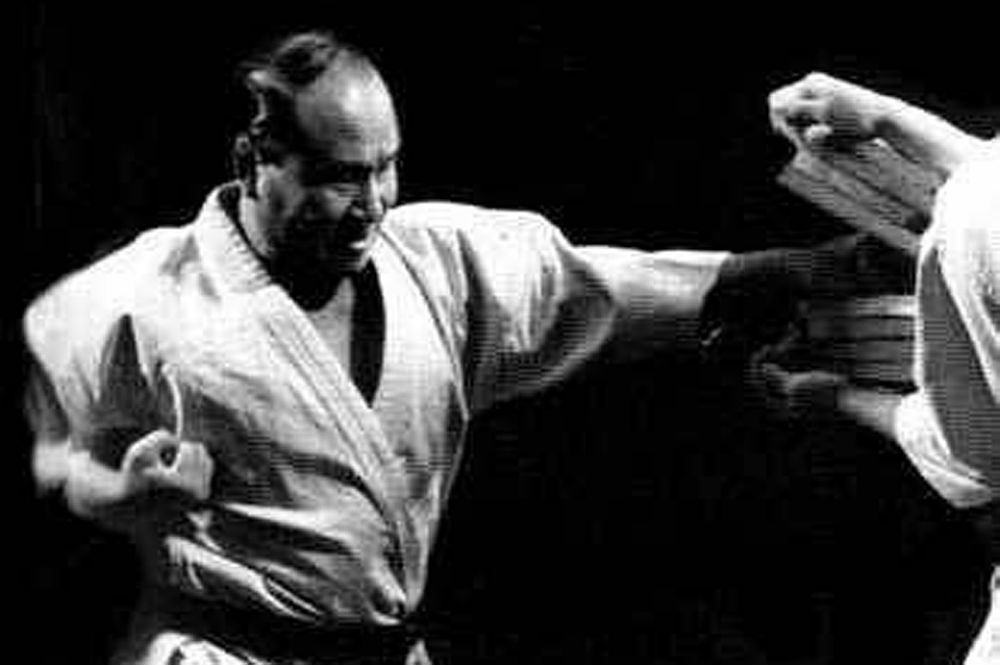
It was during one of his visits to the United States that Mas Oyama met Jacques Sandulescu, a big (190 cm and 190 kg of muscle) Romanian who had been taken prisoner by the Red Army at the age of 16, and sent to the coal mines as a slave labourer for two years. They quickly became friends and remained so for the rest of Oyama’s life, and Jacques still trained and acted as advisor to the IKO(1) for years to come. You can read a short biography of his on this site or read his autobiography at http://donbas.com.

After returning from the United States, and at the request of the press; Mas Oyama filmed a documentary in early 1954 called “Karate: Fighting Fierce Bull”. The death match with the 450kg bull lasted some 30 minutes. In April of that year, Mas Oyama also opened his first dojo – named Oyama Dojo – on a grass lot in Mejiro in Tokyo.
The year after, Mas Oyama visited the U.S.A for the third time as well as traveling around South America and Europe.
During his travels, he fought many people from different styles and snapped the neck of a whiskey bottle with a knife hand strike. It was from this time that because of his strength and skill, he became known as “the Godhand”.
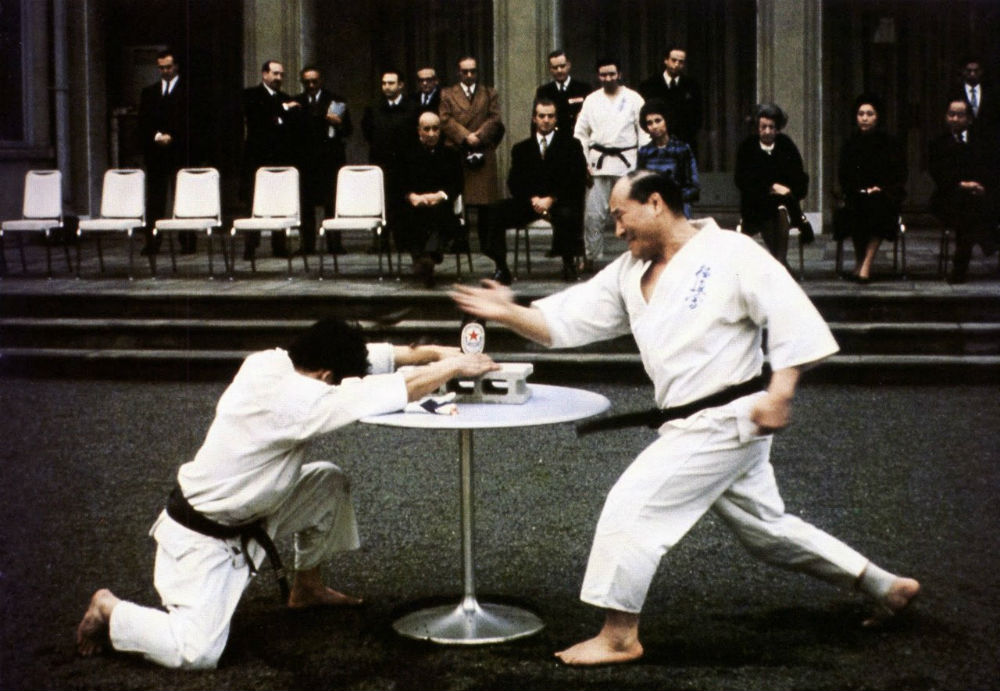
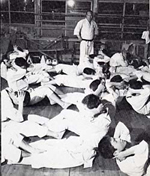
In June 1956, he opened his first real dojo (starting with 300 students) in a former ballet studio behind Rikkyo University, 500 meters from the present Honbu. By 1957 there were 700 members, despite the high drop-out rate due to the severity of training. Practitioners of other styles also came to train here for the jis-sen kumite 実戦組手 (full contact fighting). One of the original instructors, Kenji Kato, has said that they would observe those from other styles and adopt any techniques that “would be good in a real fight”. By doing so, Mas Oyama’s karate evolved into one of the most formidable style of martial arts in the world. It soon became known as “The Strongest Karate”, not only because of the incredible feats of strength and endurance that Mas Oyama performed, but also because of the rigorous requirements of the training and tournaments.
The Oyama Dojo members took their kumite seriously, seeing it primarily as a fighting art, so they expected to hit and to be hit. With few restrictions, attacking the head was common, usually with the palm heel or towel-wrapped knuckles. Grabs, throws, and groin attacks were also common. Kumite rounds would continue till one person loudly conceded defeat. Injuries occurred on a daily basis and the drop out rate was high (over 90%). They had no official do-gi and wore whatever they had. How times have changes…
In order to test his own abilities, Mas Oyama decided to perform a three hundred man kumite (San-Byakunin Kumite 三百人組手) in three days. He chose the strongest students in his dojo to fight him one at a time. After each had a turn, they started from the beginning again until all three hundred fights were completed. Each student had to face Mas Oyama about four times over the three days, though some never made it past the first day due to Oyama’s powerful blows. He defeated all of his opponents, never wavering in his resolve, despite the fact that he was injured in the process. Legend has it that Mas Oyama was willing to go for a fourth day, but no opponents were willing or able to do so.
Traveling back a few years, it was also in 1952 that Mas Oyama gave a demonstration in Hawaii. A young Bobby Lowe saw him and was stunned by the power Oyama demonstrated. It was not as though Bobby Lowe was inexperienced in martial arts. Though still quite young, his achievements to date were not much less than those of Mas Oyama himself. His father had been a Kung Fu instructor, and he had participated in any fighting art he could find. By the age of 23, he was yondan in judo, nidan in kempo, shodan in aikido, and a highly regarded welterweight boxer.
It was not long before Bobby Lowe became the first Kyokushin uchi deshi or “live-in student” of Mas Oyama’s. He trained daily with Mas Oyama for one and a half years. Eventually, an uchi deshi’s time became “1000 days for the beginning”. These uchi deshi became known as Wakajishi, or the “Young Lions” of Mas Oyama and only a few of the hundreds of applicants were chosen each year for the privilege of training full time under the Master.
In 1957, Bobby Lowe returned to Hawaii to open the first School of Oyama outside Japan and soon after the first dojo to reach the continental United States was opened in California by Hanshi Don Buck in the late 1950’s.
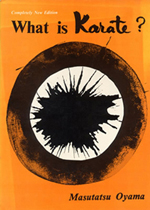
In 1958, Mas Oyama releases his first book – “What is Karate?”, which instantly became a best seller not only in Japan but all over the world with 500,000 copies printed. Oyama often travels abroad –
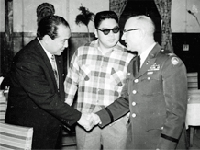
The F.B.I. In Washington invited Mas Oyama to teach and demonstrate karate in September and the month after that . The Westpoint Army School invited Mas Oyama to teach and demonstrate karate.
In June 1964, the present Honbu (the world headquarter) was officially opened and the name “Kyokushinkan” 極真, or “Society of Ultimate Truth”, was adopted for Mas Oyama’s karate organization, the International Karate Organization (IKO).
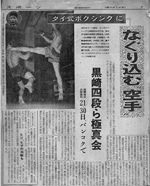
In the same year, his dojo received a challenge from Muay Thai (Thai Boxing). Oyama, believing that no other style was comparable to his, accepted the challenge and sent three students (Kenji Kurosaki, Tadashi Nakamura, Noboru Ōsawa) to Thailand who won 2 of the 3 fights, thus redeeming the reputation of his karate style.
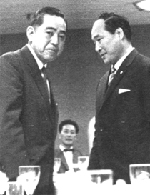
A few months after that victory for Japanese Martial Arts, in April of 1964, Eisaku Sato, former Prime Minister of Japan, who had recently won a Nobel Prize, became Kaicho(President) of the Kyokushukaikan. Mas. Oyama became Kancho(Director).
After formally establishing Kyokushin-kai, Oyama directed the organization through a period of expansion. Oyama and his staff of hand-picked instructors displayed great ability in marketing the style and gaining new members. Oyama would choose an instructor to open a dojo in another town or city in Japan. The instructor would move to that town and usually demonstrate his karate skills in public places, such as at the civic gymnasium, the local police gym (where many judo students would practice), a local park, or conduct martial arts demonstrations at local festivals or school events. In this way, the instructor would soon gain a few students for his new dojo. After that, word of mouth would spread through the local area until the dojo had a dedicated core of students. Oyama also sent instructors to other countries such as the United States of America, Netherlands, England, Australia and Brazil to spread Kyokushin in the same way.
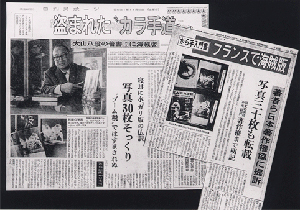
In 1965, Oyama published his “bible of karate,” entitled “This is Karate,” this introduces the technical aspects of this martial art and discusses its background, function, and future
Oyama also promoted Kyokushin by holding The All-Japan Full Contact Karate Open Championships every year. The first one took place in 1969, and saw Terutomo Yamazaki take first place.
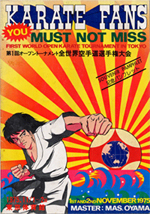
Since 1975, Oyama also held the World Full Contact Karate Open Championships once every four years in which anyone could enter from any style. It was informally known as the Olympic Games Karate – so famous was the championship.
A little later, in 1976, a documentary gets made about the first Open World Championship Karate – the movie ( a 2-parter, with part 1 released in May and part 2 in November) “The strongest karate in the world” («Chijou Saikyou Karate») became popular all over the world.
By 1988, in an effort to enhance the standard of Karate in Japan and improve skills reciprocally, Kancho requests that fighters from other styles participate in the Japan Tournament held by Kyokushin Kaikan. And in 1991, at the 5th World Karate Championships held at the Tokyo Metroporitan Gymnasium, where 250 fighters from 105 countries participated, Sosai Oyama makes his last appearance – he demonstrates Tensho Kata.
From then, Kyokushin Karate continued to spread to more than 120 countries with more than fifteen million practitioners, making it one of the largest martial arts styles in the world. It is today considered the first and most influential style of full contact karate.
Some of Mas Oyama prominent students were:
- Terutomo Yamazaki (Yamazaki Terutomo), the first champion which is the First All Japan Full Contact Championships
- Bobby Lowe, 8th dan
- Steve Arneil
- Hideyuki Ashihara, founder of Ashihara Karate
- Loek Hollander
- Howard Collins
- Phillip C. Haynes
- Shokei Matsui, who succeeded Oyama as Director of the IKO (though disputed)
- John Jarvis
- Tadashi Nakamura, founder of Seido juku
- Yoshiji Soeno, founder of Shidokan
- Miyuki Miura
- Takashi Azuma, founder of Daido Juku
- Sadaho Maeda (a.k.a. Sonny Chiba), popular Japanese actor and martial artist
- Tae Hong Choi, one of the pioneers for taekwondo in the United States
Among the other better known Kyokushin yudansha (black belts) are Sean Connery (Honorary shodan), Dolph Lundgren (sandan, former Australian heavyweight champion), and former President Nelson Mandela of South Africa (Honorary hachidan), and most recently (June 1988), the Australian Prime Minister, John Howard (Honorary godan) who was awarded the grade at the official opening of the one of the dojo in Sydney.
Mas Oyama summed up his entire martial arts philosophy in eleven mottos, known as the Zayu no Mei Juichi Kajo, which are central to his teaching:
- The Martial Way begins and ends with courtesy. Therefore, be properly and genuinely courteous at all times.
- Following the Martial Way is like scaling a cliff — continue upwards without rest. It demands absolute and unfaltering devotion to the task at hand.
- Strive to seize the initiative in all things, always guarding against actions stemming from selfish animosity or thoughtlessness.
- Even for the martial arts practitioner, the place of money cannot be ignored. Yet one should be careful never to become attached to it.
- The Martial Way is centered on posture. Strive to maintain correct posture at all times.
- The Martial Way begins with one thousand days and is mastered after ten thousand days of training.
- In the martial arts, introspection begets wisdom. Always see contemplation on your actions as an opportunity to improve.
- The nature and purpose of the martial arts is universal. All selfish desires should be roasted in the tempering fires of hard training.
- The martial arts begin with a point and end in a circle. Straight lines stem from this principle.
- The true essence of the Martial Way can only be realized through experience. Knowing this, learn never to fear its demand.
- Always remember, in the martial arts, the rewards of a confident and grateful heart are truly abundant
- 一、武の道は礼に始まり礼に終わる、よって常に礼を正しくすべし
- 二、武の道の探求は断崖を攀じ登るがごとし、休む事無く精進すべし
- 三、武の道においては全てに先手あり、しかれども私闘なし
- 四、武の道においても金銭は貴いものなり、しかれども執着すべからず
- 五、武の道は姿なり何事においても、常に姿を正しくすべし
- 六、武の道においては千日を初心とし、万日の稽古をもって極みとす
- 七、武の道における自己反省は、常に練達への機会なり
- 八、武の道は宇のためにあるものなり、修練にて私心を忘れるべし
- 九、武の道においては点を起とし円を終とす、線はこれに付随するものなり
- 十、武の道において真の極意は体験にあり、よって体験を恐れるべからず
- 十一、武の道において信頼と感謝は、常に豊かなる収穫を得ることを忘るべからず
- Hitotsu. Bu no michi wa rei ni hajimari rei ni owaru. Yotte tsune ni rei o tadashiku subeshi.
- Futatsu. Bu no michi no tankyū wa, dangai o yojinoboru ga gotoshi, yasumu kotonaku shōjin subeshi.
- Mittsu. Bu no michi ni oite wa subete ni sente ari, shikare domo shitō nashi.
- Yottsu. Bu no michi ni oite mo kinsen wa tōtoi mono nari, shikare domo shūchaku subekarazu.
- Itsutsu. Bu no michi wa sugata nari, nanikoto ni oite mo. Tsune ni sugata o tadashiku subeshi.
- Muttsu. Bu no michi ni oite wa sennichi o shoshin toshi, mannichi no keiko o motte kiwami tosu
- Nanatsu. Bu no michi ni okeru jikohansei wa, tsune ni rentatsu he no kikai nari.
- Yatsu. Bu no michi wa u notameni aru mono nari, shūren nite shishin o wasurerubeshi.
- Kokonotsu. Bu no michi ni oite wa ten o kitoshi maru o owatosu. Sen wa kore ni fuzui suru mono nari.
- To. Bu no michi ni oite shin no gokui wa taiken ni ari. Yotte taiken o osoreru bekarazu.
- Jūichi. Bu no michi ni oite shinrai to kansha wa, tsune ni yutaka naru shūkaku o uru koto o wasuru bekarazu.

Sadly, Mas Oyama (a non-smoker) passed away from lung cancer at St. Luke’s Hospital, Tokyo on April 26, 1994 at the age of 70.
Mas Oyama’s unexpected death left his organization in a very confused state. Prior to his death, he stated in his will that Yukio Nishida would be his successor to lead the IKO, but on his deathbed he spontaneously appointed Akiyoshi Matsui (also known by his Korean name of Moon Jang Gyu (Hangul: 문장규; Hanja: 文章圭)), then Godan (5th Dan). Perhaps keeping in mind that Sosai was a Korean native living in Japan and so too is Matsui is not simply a coincidence, so the fact that Sosai left his beloved association in the hands of a fellow countryman is not beyond reason. Indeed, no-one can doubt Matsui, who was the youngest ever knockdown world champion and is one of just a handful of Kyokushin practitioners to complete the 100 man Kumite. Qualified though Matsui was, both in Kyokushin Karate and in management of the organization, many of the higher yudansha (black belts) and Branch Chiefs of the organization took exception to this. This has resulted in a splintering of the IKO into many groups — the IKO(1) under Matsui, the IKO(2) under Nishida (now Midori), and the IKO(3) under Yoshikazu Matsushima. Each group claims to be the true successor to Mas Oyama’s organization. This was then followed by IKO(4) under Tezuka, IKO(5) under Hasegawa, IKO(6) under Royama, IKO(7) under Kuristina Oyama (daughter of Mas Oyama), …
Another group of Kyokushin karateka 空手家 decided to affiliate themselves with Hanshi 範士 (Master) Steve Arneil of Great Britain, who left the Japanese Kyokushin organization in 1991 to form the International Federation of Karate (IFK). Maybe a Kyokushin diaspora will be a good thing, since in all good families, some of the children eventually do leave home and start their own families. Some of the splinter groups may remain faithful to the Kyokushin principles, such as Hanshi Steve Arneil – in Great Britain – who was set on passing on his teachings of Kyokushin karate as it was originally taught to him by Mas Oyama. Many others, such as Shigeru Oyama and Tadashi Nakamura in the U.S., have taken it further by developing their own style based on Kyokushin. With Kyokushin practitioners featuring in MMA in Bass Rutten and 5x World Strongest Man winner Mariuz Pudzainowski, UFC in Champion Georges St-Pierre and K-1 with World Champions Andi Hug, Semmy Schilt, Francisco Filho and Glaube Feitosa, it is clear that Kyokushin continues to develop and Sosai’s legacy is set to continue long into the future.
The legend lives on… In Japan, books were written by and about him, feature-length films splashed his colourful life across the big screen, and comic books recounted his many adventures.
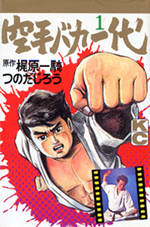
A manga about Oyama’s legacy was written by Ikki Kajiwara. He called the magna Karate Baka Ichidai (“A Karate-Crazy Life”) and it was published in Weekly Shonen Magazine in 1971, The art in Karate Baka Ichidai was done by Jiro Tsunoda and Joya Kagemaru. A 47 episode anime adaptation was released in 1973, the anime had several changes in the plot and for some reason replaced Mas Oyama with a fictional character named Ken Asuka as the main character. Although some of its plot was different from the manga, the anime was still inspired by Oyama’s legacy like in the manga.
Oyama was played by Japanese actor Sonny Chiba in the martial arts film trilogy based on the manga, Champion of Death (1975), Karate Bearfighter (1975), and Karate for Life (1977). Ikki Kajiwara, Jiro Tsunoda and Joya Kagemaru were credited as the original creators of the film trilogy. Oyama himself actually appeared in the first two films.
The 2004 South Korean film Fighter in the Wind or Baramui Fighter portrayed Oyama’s life story.
SNK video games character, Takuma Sakazaki (AKA Mr. Karate), from King of Fighters and Art of Fighting series of games, was inspired by Mas Oyama. Takuma Sakazaki is the founder and grandmaster for the fictional Kyokugenryu Karate, which is heavily based on Mas Oyama’s Kyokushin Karate.
Grappler Baki manga character Doppo Orochi is a master karateka based on Mas Oyama, founding his own school of Karate, Shinshinkai; the other most known Keisuke Itagaki’s work, Garouden, features a mighty character, Shozan Matsuo, who’s apparently again inspired by Oyama.
Osu!
Osu!